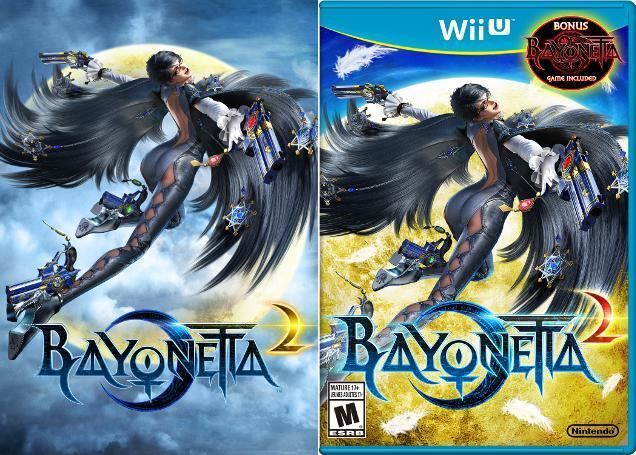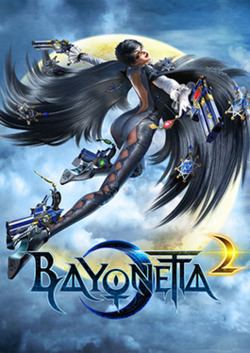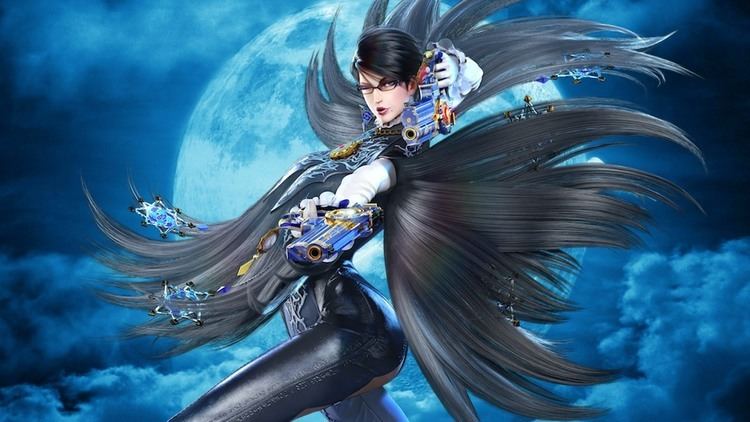9.6 /10 1 Votes9.6
9.5/10 IGN Director(s) Yusuke Hashimoto Initial release date 20 September 2014 | 10/10 GameSpot 91% Metacritic Programmer(s) Minota Kenshin Developer Platinum Games | |||||||||||||||||||||||||||||||||
 | ||||||||||||||||||||||||||||||||||
Producer(s) Atsushi InabaHitoshi Yamagami Designer(s) Hirono SatoJunichi OkaAkiteru Naka Artist(s) Mari ShimazakiYusuke Hashimoto Writer(s) Hideki KamiyaBingo Morihashi Genres Action game, Hack and slash Similar Platinum games, Hack and slash games, Other games | ||||||||||||||||||||||||||||||||||
Bayonetta 2 game movie all cutscenes 1080p hd
Bayonetta 2 (ベヨネッタ 2, Beyonetta Tsū) is an action hack 'n' slash video game developed by PlatinumGames and published by Nintendo for Wii U. It is the sequel to the 2009 game Bayonetta, and was directed by Yusuke Hashimoto and produced by Atsushi Inaba and Hitoshi Yamagami from Nintendo, under supervision by series creator Hideki Kamiya.
Contents
- Bayonetta 2 game movie all cutscenes 1080p hd
- Bayonetta 2 review
- Gameplay
- Setting and characters
- Story
- Development
- Music
- Reception
- Sales
- Other media
- References

Bayonetta 2 was announced on September 13, 2012 exclusively for Wii U, unlike the previous game which was released on both Xbox 360 and PlayStation 3. The titular character, Bayonetta, sports a new costume and hairstyle and the game itself features a new two-player mode. The game is also the second Bayonetta product to receive Japanese voiceovers, using the same cast that voiced the Bayonetta: Bloody Fate anime film by Gonzo.

Bayonetta 2 was released in September 2014 in Japan and October 2014 for the rest of the world. The Special and First Print Editions of the game included a Wii U port of the original Bayonetta as a separate disc inside the case. The game received critical acclaim from many reviewers, praising the combat system and overall improvements from the first game.

Bayonetta 2 review
Gameplay

Bayonetta 2 carries on the action-style gameplay of its predecessor, in which players control the eponymous Bayonetta as she fights against various angelic and demonic forces using combinations of melee attacks and gunplay. Dodging enemy attacks at the last second activates 'Witch Time', slowing down enemies around Bayonetta and allowing players to easily retaliate and solve certain environmental puzzles. Players are also able to use special moves called Torture Attacks, trapping opponents in infernal devices for extra points. Weapon customization from the first game also returns, allowing players to equip combinations of new weapons on both Bayonetta's hands and feet. A large array of weapons can be equipped, including the character's signature guns, a bow, swords and other forms of projectile weapons. Players earn grades during combat, with the highest 'Pure Platinum' grade achieved by performing high numbers of combos, in the fastest time possible, without being damaged. As with the previous game, Bayonetta can use Torture Attacks on her enemies, conjured torture devices that finish off single enemies in gruesome ways and grant a bonus to the player.

Bayonetta 2 also adds a new gameplay element called Umbran Climax which can be activated when the player has a full magic gauge. Similar to the state of boss fights in the first game, this technique strengthens Bayonetta's attacks and combos with extra Wicked Weaves and Infernal Demon summons for a short period of time. This increases their overall range and damage and also replenishes Bayonetta's health when in use.
Setting and characters
Most of Bayonetta 2 takes place on the fictional sacred mountain of Fimbulventr and the nearby town of Noatun, which are located in the Middle East. The main character Bayonetta (voiced by Hellena Taylor) travels to the mountain to find the Gates of Hell so that she can save her friend Jeanne (voiced by Grey DeLisle-Griffin).
Returning characters include Rodin (voiced by Dave Fennoy), the bartender of Gates of Hell who supplies Bayonetta with powerful weapons; Luka (voiced by Yuri Lowenthal), a journalist who provides Bayonetta with valuable information; and Enzo (voiced by John Kassir), an informant who provides comic relief for the game. New characters include Loki (voiced by Mark Daughtery), an amnesiac boy who guides Bayonetta to the mountain; the Masked Lumen (voiced by Crispin Freeman), a powerful Sage who is Bayonetta's new rival; and Loptr (voiced by TJ Ramini), the mysterious Prophet who is apparently allied with the Masked Lumen.
Story
A few months after the first Bayonetta, Bayonetta is in the middle of Christmas shopping with Enzo when a group of angels attack the city during a stuntplane flyover. Teaming up with fellow witch and friend Jeanne, she is on the verge of winning the battle until a demon summoning goes wrong. Despite Bayonetta being able to put down the demon, Jeanne is attacked, causing her soul to be claimed by the depths of Inferno. At the same time, a Lumen Sage is brought to the present day by a mysterious figure who promises him the chance for revenge.
Upon a tip from her informant Enzo, Bayonetta heads to the sacred mountain of Fimbulventr. An entrance to the realm of Inferno, the Gates of Hell, is said to be inside and Bayonetta plans to use it to save her friend. Bayonetta arrives in Noatun, the city at the foot of the mountain, and meets a boy called Loki who is trying to reach Fimbulventr for reasons he cannot remember. The pair of them strike a deal to travel together as Loki claims his powers will be needed in order to reach the realm to Inferno. Though able to learn some information about Loki's lost memories thanks to Luka, the journey suffers setbacks from angel and demon attacks alike. Both Loki and Bayonetta are also hunted by the masked Lumen Sage and the mysterious Prophet who reveals that he knows Loki. The Prophet also shows Bayonetta a vision of the past that implies the Witch Hunts 500 years ago were not truly caused by Balder.
After narrowly escaping their aggressors, Bayonetta reaches Inferno and travels into its depths to save Jeanne's soul. With the help of Rodin, Bayonetta is able to revive Jeanne's soul back to the human world. However, the masked Sage attacks again and finally reveals his true identity as a young Balder who is trying to hunt down Loki as part of his revenge. Even though she is able to save the boy from Balder's attacks, Loki suddenly loses control of his powers and sweeps both Bayonetta and Balder into a time rift that sends them 500 years into the past. Now in Vigrid during the Witch Hunts, Bayonetta meets her mother Rosa and the two witches work together to fight back against the onslaught of angels. When they become separated, Bayonetta encounters Loptr, a doppelgänger of Loki and the one who would eventually become the Prophet in the present day. Loptr claims that the Eyes of the World, one of which Bayonetta possesses, belong to him. Later meeting with the young Balder, Bayonetta arrives too late to stop Loptr from murdering Rosa. Bayonetta realizes that Loptr is the one that Balder should really be after instead of Loki and that Loptr had brought the Sage to the present day to use as a pawn. The two of them decide to work together and return to the present to stop Loptr's plans. Meanwhile, in the present day, Luka encounters Loki having now escaped from Inferno. Claiming that he now remembers everything, Loki pleads Luka to take him to Fimbulventr.
With the assistance of a revived Jeanne, Bayonetta and Balder reach the top of Fimbulventr and find Loptr having already captured Loki. Loptr explains that he and Loki were once the God of Chaos, Aesir, the true creator of the Eyes of the World. Aesir had split his power amongst humanity to create the Eyes, but had also split his very soul into two halves of good and evil in the process. Loki, the good half, was given the power to control the Eyes directly and Loptr promptly takes that power for his own. Despite their efforts, Loptr takes both of the Eyes from Balder and Bayonetta and transforms into Aesir with the intent to rule over humanity as their god. As the final clash takes place, Loki remembers that Aesir's true power is to erase anything he wants from the world. He uses that power to destroy the Eyes, weakening Loptr and making him easy fodder for the combined summoning Bayonetta, Balder, and Jeanne perform moments later. Loptr, with his body destroyed and only his soul remaining, attempts to escape to another time to try his plan again in an era where the Eyes still exist. Balder stops him and absorbs the evil soul, despite warnings from Loki that doing so will eventually poison his very core. Balder reveals he knows that Bayonetta is his daughter and asks her to stop him should Loptr's evil lead him astray. Realizing that her father's actions during their first meeting were not his own, Bayonetta can only watch as the Sage is returned to his own time. With Loptr and the Eyes gone, Loki says he plans to take a break from the world's affairs but that he and Bayonetta may meet again in the future. He wishes her goodbye and then fades away.
A few days pass since the events at Fimbulventr. Bayonetta and Jeanne are taking advantage of the post holiday sales, watching with amusement at Luka being roped into advertising Rodin's bar. Bayonetta suddenly remembers that she forgot Enzo and promptly sees him crashing down the street in a plane with angels in pursuit. Despite her annoyance at having ruined another dress, Bayonetta teams up with Jeanne to take to battle once again.
In a post-credits scene, Balder is shown returning to his time period, now corrupted by the evil of Loptr's soul. Donning his golden mask from the first game, he begins his plot to reunite the three realms, thus setting up the events of the first Bayonetta.
Development
Shortly after the release of Bayonetta, Hideki Kamiya discussed with Yusuke Hashimoto ideas for sequels and spin-off games from the title. Despite these discussions, Kamiya believed they would never release a sequel. However, Kamiya's Twitter account later stated that he may release the sequel if Bayonetta sold well. Bayonetta 2 was revealed during a Nintendo Direct on September 13, 2012. The game's Wii U exclusivity was met with complaints by fans of the original game; PlatinumGames producer Atsushi Inaba responded that Bayonetta 2 would not exist if Nintendo had not partnered with the developer to make the game. Work on the game was based on feedback the staff received from the original Bayonetta to bring various improvements. Nintendo was not involved in the making of the game other than as an "observer" and the staff were pleased with their experience. One of the improvements made by staff was to the movements of enemies: in the first game, there was a single enemy movement when Bayonetta struck them, while in Bayonetta 2, they have differing animations depending on the direction of Bayonetta's attack. The architecture for the main city environment, Noatun, was based on cities in Belgium and Italy, such as Bruges (church interiors), Brussels (the grand buildings), Florence (city streets and houses) and Venice (the canal network).
In the Nintendo Wii U Direct from January 2013, PlatinumGames showed a development trailer for the game. They confirmed game development was going smoothly, but did not go into many gameplay details. A playable demo of the game was featured at Nintendo's booth during E3 2013, following the reveal of the game's first gameplay trailer. A multiplayer mode was also announced, along with the option of a touch-based control scheme and the confirmation that the game will support Off-TV Play. In the Nintendo Direct from February 2014, another trailer for the game was released, showing off the new environments players can expect as well as some of the basic story elements of the game. Further gameplay was also released, revealing the use of Japanese voice actors for the Japanese release, new weapons for Bayonetta to use as well as the use of the new youth character as being playable. As of the Bayonetta 2 Direct, the game is slated for September 20, 2014 in Japan and in October 24, 2014 for the rest of the world. At E3 2014, it was announced the game would include a port of the original Bayonetta, which will include exclusive Nintendo costumes, dual audio voice tracks, and touch controls. The original game will be a digital download via the Nintendo eShop and on a separate disc for retailers.
Music
The music of Bayonetta 2 was composed by a group of members led by Masami Ueda, many of whom returned after being featured on the soundtrack for the first game. Ueda states that he finds the score for Bayonetta 2 much livelier than the one for Bayonetta and explains they attempted to create new elements in the music by switching out certain instruments for others.
A key difference in the soundtrack between the games is the inclusion of dynamic music for boss fights based on the progression in Bayonetta 2. Ueda states that the music is broken up into phases and are set off by triggers based on animations and other cues in the scene which allow for swells in the music to match up the action onscreen. A similar approach was done for the stage tracks as well, with as many as 10 shorter loops mixed together that transition based on the player's progress through the stage. Compared to the original Bayonetta's 150 tracks, Bayonetta 2 has 183 tracks with higher audio quality.
Like the original game, Bayonetta 2 features a cover of an old song but remixed into the signature style of the games, "Moon River" by Andy Williams. Both the remixed version and the original are included in the game, much like how "Fly Me To The Moon" was used as the main theme song for Bayonetta. The game's battle theme, "Tomorrow is Mine", was one of the first pieces of music revealed in its entirety during promotion of the game. Both of these songs were performed by Keeley Bumford. Also like the original game, Bayonetta 2 received a five disc original soundtrack, which was released in Japan on October 29, 2014.
Reception
Bayonetta 2 received critical acclaim. It received an aggregated score of 91/100 on Metacritic based on 80 reviews. The Japanese magazine Famitsu's four reviewers collectively awarded the game a score of 38 out of 40. Edge awarded Bayonetta 2 a score of 10 out of 10. The magazine's reviewer described it as "a riotous, spectacular work of the highest order of camp" and praised the game for the extent of its customisability and for refining problematic elements from the first Bayonetta, with tighter pacing and the removal of "sudden, mid-cinematic, instafail QTEs". The reviewer concluded, "This is a game that you can complete in ten hours, but play and replay forever. … It is a masterclass in combat design, in videogame variety, in the balance between accessibility and depth." GameSpot reviewer Mark Walton said the game "will be remembered as an absolute classic" and awarded it a perfect 10/10, the seventh game in the site's history to receive that score. Chris Carter from Destructoid also rated it a 10/10, where he declared it as "one of the finest action games of all time", alongside Devil May Cry 3.
Several reviews agreed that the game was an improvement on its predecessor, despite acknowledgement that its combat mechanics were largely unchanged: Eurogamer's Martin Robinson concluded, "Bayonetta 2's biggest disappointment may be that it's an iterative sequel, but it's not such a problem when it's iterating on genius." IGN's Jose Otero commented that its art direction and pacing "make Bayonetta 1 look poor by comparison," while GameTrailers called it "sharpened to a nearly flawless degree" compared to its predecessor, praising the variety in addition to the style mixed with the gameplay, where the game "thrives on throwing players into complete madness and letting them conquer it." Chris Carter at Destructoid stated "Four years later and Platinum hasn't lost its edge with Bayonetta 2. It's just as stylish and as fun as ever"
Of the game's new features, the co-operative online Tag Climax mode was welcomed by GameSpot's Mark Walton and by Eurogamer's Martin Robinson, who praised it for requiring the player to gain a deep understanding of the combo scoring system; however, IGN's Otero commented that the fun it provides was restricted to short bursts, and Polygon's Arthur Gies found the mode's co-operative mechanics at odds with its competitive focus on scoring. Otero and Robinson both criticized the game's optional touchscreen-based control system, intended to improve accessibility for new players, as very limited in comparison to the game's main control scheme.
Sales
In Japan, Bayonetta 2 sold approximately 39,000 units in its first week of release, much fewer than were sold of the original Bayonetta in its debut week. After its third week of release, Bayonetta 2 had sold approximately 50,000 units in Japan. The title was the seventh best-selling game in the UK in its first week of release, but was absent from the Top 40 best-seller list in its second week.
Other media
Bayonetta appears as a playable fighter via downloadable content in the 2014 Nintendo fighting games Super Smash Bros. for Nintendo 3DS and Wii U. She fights using various methods including combos, Witch Time, and Bullet Arts abilities from her series, and has alternate costumes based on her designs in both Bayonetta and Bayonetta 2. She was revealed on December 15, 2015 during the Super Smash Bros. Final Video Presentation, and was made available alongside a stage based on the Umbra Clock Tower from Bayonetta on February 3, 2016.
